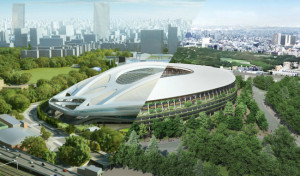John Carino
WRT 205 Reflection
[1] How well does the title provocatively focus the reader’s attention, as well as the lede? Is it thoughtful, creative, clever? Does it lead the reader into the text and provide some insight into the issue?
The title of an article or piece of writing is a very powerful tool. A writer has essentially one line to draw the attention and interest of a reader. A catchy title has to be provocative, or maybe raise a question that may intrigue a potential reader. With this article title I chose to propose a question that relates to the topic I continue to discuss. “Was Japan just in their decision to scrap Zaha Hadid’s competition winning design?” I do a few things here, I place an action that is an important part of my article, presenting that Japan had scrapped Zaha Hadid’s design. This way the reader has an idea of what the topic I may be exploring is. I continue by questioning the justness and morality of this decision, hopefully gaining the interest of the reader who may now be thinking and curious of what they could have done to raise this ambiguity of their actions.
[2] How well does the introductory section of the article invite the reader into the paper, as well as offer up exigency? How does it locate a problem or controversy within a context that provides background and rationale?
I began my article with a lede that presents statement about money in reference to architecture, then lead that into how that relates to Japan’s actions. I share a broad statement about Japan’s overall reasoning for scrapping her design, but then hint that that may not be the real and only reason. This gives the reader some context to the situation, but intrigues them to continue reading. The problem that it locates within the controversy is that Japan is making a claim for their reasoning, I begin to hint that this claim may not be as accurate and true as the say it is.
[3] How well does the writer offer up a strong ‘idea’ that requires analysis to support and evolve it, as well as offers some point about the significance of evidence that would not have been immediately obvious to readers.?
I am making a bold claim by saying that Japan lied to and deceived Zaha Hadid. This argument requires thorough support through analyzing all perspectives and developments of the situation. I also believe that as an architecture student there were aspects I was able to see analyzing and studying my sources that others may have not fully understood or picked up on. I attempt to relay these in my article in a clear and understandable way.
[4] How well does the writer show clarity of thought; uniqueness of presentation; evidence of style; and historicized topics?
I articulate my own style when I input my opinion when appropriate. I also chose a topic that I believed not many people outside of the architecture discipline would know about. I hope that the readers would gain new insight into a field they did not know much about and how influential something like this could actually be to them.
[5] How well does the writer recognize that a NYTs Magazine audience will challenge ideas that are overgeneralized or underdeveloped or poorly explained? (that is, did the writer avoid cliché and vagueness or address points/issues readers are likely to have?) How well did the writer decide about how to develop, sequence, and organize material?
I attempted to avoid vagueness and general statements by integrating many quotes and first hand details from sources that are difficult to misinterpret. My piece synthesizes years of development of this case, which has been in development since 2012. I follow the progression as a narrative, analyzing and giving my opinion on each development along the way.
[6] How well does the writer research a controversy, develop a persuasive stance, utilize research about the topic, and join the ‘debate’ by making an argument of importance?
I originally came across this controversy through research when attempting to find architectural controversies at an international scale. This topic in particular interested me as I was able to form a basic opinion pretty quickly from my first few sources I read. I knew however it would require more extensive reader to be able to construct a strong supported argument that could convince an entire audience. The implications of this controversy go beyond just Japan and Zaha Hadid and her firm, as it could affect thousands including the local community and the millions of people watching the Olympics if the stadium is unfinished or has any flaws due to a rushed construction. I hope in my argument to share the controversy, and not only who is at fault but what consequences their decisions may have.
[7] How well does the writer meet or exceed research expectations of assignment requirements (6 appropriate secondary sources, 1 visual source, (or more) and primary research? ).
As this topic is significantly centered on a physical structure, visuals are a powerful tool that I utilize to support me argument. For example showing the similarities between Kuma’s design and Hadid’s. I also show the amount of progress Hadid had made in her design already when Japan scrapped it, presenting how she should rightly be paid for her work. I also integrate many quotes from many participants in the controversy, giving the reader personal opinions that give new perspectives to the situation.
[8] How well does the writer integrate secondary and primary sources (that support and complicate the topic) effectively into the text, introducing and contextualizing them, and “conversing” (i.e. no drop-quoting) in ways that deepen and complicate the analysis?
Integrating quotes is important, I give context to my quotes so that they cannot be misinterpreted. Allowing for a quote to be misinterpreted completely defeats the purpose of utilizing one. Quotes are power tools, that when integrated correctly can really help create a convincing argument. I use quotes in my article in just that way.
[9 How well does the writer persuade an audience to consider claims made from a particular position of authority on which you have built your research? How strong and effective is the writer’s use of rhetorical tools (ethos, logos, pathos)?
I am able to persuade the reader by sharing multiple sources that are factual and opinionated that reach similar conclusions about the morality of Japan’s actions and decision making. By being clear in my writing, my ideas can more easily be absorbed by readers.
10] How well does the writer select appropriate, interesting, revealing visual? Has the writer placed a visual strategically in the essay and provided relevant commentary on and/or analysis of them? Do the visuals contribute to the essay in meaningful ways (i.e. would the essay be affected if the writer took the visual away)?
I utilize multiple visuals, including a video to help the reader understand a visual context to the argument I am making. Visuals are particularly important in my article because architecture is a profession that manifests itself through buildings and images. Without giving a visual context to the reader, I cannot possible fully relay to them all the information they need to make their own decision or opinion of what to believe.
[11] How well does the writer show development of final article using various drafts, in-class peer editing and workshops, and/or teacher comments?
Various drafts are import to narrow down and figure out exactly what claim you want to make. They are also important to figure out the best way to organize the order of paragraphs and how to frame your argument, as well as integrate your own opinion in supported ways.
[12] How well does the writer use hyperlinks—are they effective/appropriate?
I utilize hyperlinks by embedding a video that is very revealing to a point I make. In particular that Zaha Hadid and her firm had put a significant amount of work and progress into their design. What better way to describe that then share a video showcasing the work?
[13] How well did the writer edit for grammar, style, and usage effectively? Does the writer’s attention to sentence level issues help him/her establish authority or credibility on the issue?
Having good grammar is always good because it shows you are well educated and have reviewed your work multiple times. Style is important because it gives your work personality, and when you are making a claim and trying to convince a reader of something, some of “you” has to come through your writing so it is not bland, and your reader can relate more. Using the style of a New York Times article with short paragraphs helps the reader grasp each argument, piece of information, and claim one piece at a time. It also requires the writer to place more precision on each of these paragraph, making sure each is clear and articulate.


